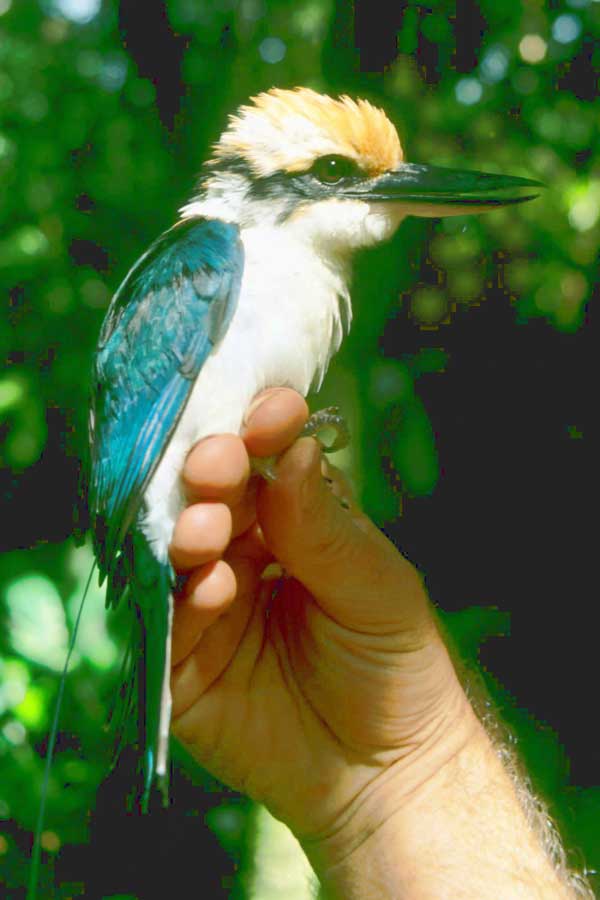
Todiramphus cinnamominus (*)
Superregnum: Eukaryota
Regnum: Animalia
Subregnum: Eumetazoa
Cladus: Bilateria
Cladus: Nephrozoa
Superphylum: Deuterostomia
Phylum: Chordata
Subphylum: Vertebrata
Infraphylum: Gnathostomata
Megaclassis: Osteichthyes
Superclassis: Sarcopterygii
Superclassis: Tetrapoda
Cladus: Reptiliomorpha
Cladus: Amniota
Classis: Reptilia
Cladus: Eureptilia
Cladus: Romeriida
Subclassis: Diapsida
Cladus: Sauria
Infraclassis: Archosauromorpha
Cladus: Crurotarsi
Divisio: Archosauria
Cladus: Avemetatarsalia
Cladus: Ornithodira
Subtaxon: Dinosauromorpha
Cladus: Dinosauriformes
Cladus: Dracohors
Cladus: Dinosauria
Ordo: Saurischia
Cladus: Eusaurischia
Cladus: Theropoda
Cladus: Neotheropoda
Cladus: Averostra
Cladus: Tetanurae
Cladus: Avetheropoda
Cladus: Coelurosauria
Cladus: Tyrannoraptora
Cladus: Maniraptoromorpha
Cladus: Maniraptoriformes
Cladus: Maniraptora
Cladus: Pennaraptora
Cladus: Paraves
Cladus: Eumaniraptora
Cladus: Avialae
Infraclassis: Aves
Cladus: Euavialae
Cladus: Avebrevicauda
Cladus: Pygostylia
Cladus: Ornithothoraces
Cladus: Euornithes
Cladus: Ornithuromorpha
Cladus: Ornithurae
Cladus: Carinatae
Parvclassis: Neornithes
Cohors: Neognathae
Cladus: Neoaves
Ordo: Coraciiformes
Familia: Alcedinidae
Subfamilia: Halcyoninae
Genus: Todiramphus
Species: Todiramphus cinnamominus
Subspecies: T. c. cinnamominus – †T. c. miyakoensis
Name
Todiramphus cinnamominus (Swainson, 1821)
Synonyms
Halcyon cinnamomina (protonym)
References
Zoological Illustrations 2 text, pl.67.
Vernacular names
čeština: Ledňáček mikronéský
Deutsch: Zimtkopfliest
English: Micronesian Kingfisher
español: Alción micronesio
français: Martin-chasseur cannelle
Nederlands: Micronesische ijsvogel
Türkçe: Mikronezya yalıçapkını
The Guam kingfisher (Todiramphus cinnamominus) is a species of kingfisher from the United States Territory of Guam. It is restricted to a captive breeding program following its extinction in the wild due primarily to predation by the introduced brown tree snake.
Taxonomy and description
The mysterious extinct Ryūkyū kingfisher, known from a single specimen, is sometimes placed as a subspecies (T. c. miyakoensis; Fry et al. 1992). Among-island differences in morphological, behavioral, and ecological characteristics have been determined sufficient that Micronesian kingfisher populations, of which the Guam kingfisher was considered a subspecies, should be split into separate species.
This is a brilliantly colored, medium-sized kingfisher, 20–24 cm in length. They have iridescent blue backs and rusty-cinnamon heads. Adult male Guam kingfishers have cinnamon underparts while females and juveniles are white below. They have large laterally-flattened bills and dark legs. The calls of Micronesian kingfishers are generally raspy chattering.
Behavior
Guam kingfishers were terrestrial forest generalists that tended to be somewhat secretive. The birds nested in cavities excavated from soft-wooded trees and arboreal termitaria, on Guam (Marshall 1989). Micronesian kingfishers defended permanent territories as breeding pairs and family groups (Kesler 2006). Both sexes care for young, and some offspring remain with parents for extended periods. (Kesler 2002). Research suggests that thermal environment has the potential to influence reproduction (Kesler 2003).
Conservation status
The Guam kingfisher population was extirpated from its native habitat after the introduction of brown tree snakes (Savidge 1984). It was last seen in the wild in 1988, and the birds are now U.S. listed as endangered (U.S. Fish and Wildlife Service 1984). The Guam kingfisher persists as a captive population of fewer than two hundred individuals (as of 2017) in US mainland and Guam breeding facilities. However, there are plans to reintroduce the Guam birds to another suitable island called Palmyra Atoll by the first quarter of 2022, and potentially also back to their native range on Guam if protected areas can be established and the threat of the brown tree snakes is eliminated or better controlled (US Fish and Wildlife Service 2004). Unfortunately, however, three decades of research and management has yielded little hope for safe habitats on Guam.
References
BirdLife International (2017). "Todiramphus cinnamominus". IUCN Red List of Threatened Species. 2017: e.T22725862A117372355. doi:10.2305/IUCN.UK.2017-3.RLTS.T22725862A117372355.en. Retrieved 13 November 2021.
Laws, R.J., and D.C. Kesler. 2012. "A Bayesian network approach for selecting translocation sites for endangered island birds." Biological Conservation 155:178-185.
Kesler, D.C., and S.M. Haig. 2007. "Conservation biology for suites of species: demographic modeling for the Pacific island kingfishers." Biological Conservation 136:520-530.
Kesler, D.C., and S.M. Haig. 2007. "Multi-scale resource use and selection in cooperatively breeding Micronesian Kingfishers." Journal of Wildlife Management 71:765-772.
Kesler, D.C., and S.M. Haig. 2007. "Territoriality, prospecting, and dispersal in cooperatively breeding Micronesian Kingfishers." Auk 124:381-395.
Kesler, D.C., and S. M. Haig. 2005. "Microclimate and nest site selection in Micronesian kingfishers." Pacific Science 59:499-508.
Kesler, D.C. 2006. Population demography, resource use, and movement in cooperatively breeding Micronesian Kingfishers. Doctoral dissertation. Oregon State University. Corvallis, OR.
Kesler, D.C., and S.M. Haig. 2004. "Thermal characteristics of wild and captive Micronesian kingfisher nesting habitats." Zoo Biology 23:301-308.
Fry, C.H., K. Fry, A. Harris. 1992. Kingfishers, Bee-eaters, and Rollers. Princeton University Press. Princeton, NJ.
Haig, S.M., and J.D. Ballou. 1995. Genetic diversity among two avian species formerly endemic to Guam. Auk 112: 445–455.
Haig, S.M., J.D. Ballou, and N.J. Casna. 1995. Genetic identification of kin in Micronesian Kingfishers. Journal of Heredity 86: 423–431.
Marshall, S.D. 1989. Nest sites of the Micronesian Kingfisher on Guam. Wilson Bulletin 101, 472–477.
Pratt, H.D., P.L. Bruner, and D.G. Berrett. 1987. The Birds of Hawaii and the Tropical Pacific. Princeton University Press. Princeton, NJ.
Savidge, J. A. 1987. Extinction of an island forest avifauna by an introduced snake. Ecology 68:660-668.
U.S. Fish and Wildlife Service, 2004. Draft Revised Recovery Plan for the Sihek or Guam Micronesian Kingfisher (Halcyon cinnamomina cinnamomina).
U.S. Fish and Wildlife Service, 1984. Endangered and threatened wildlife and plants: determination of endangered status for seven birds and two bats on Guam and the Northern Mariana Islands. Federal Register 50 CFR Part 17 49(167), 33881–33885.
U.S. Fish and Wildlife Service, 2004. Draft Revised Recovery Plan for the Sihek or Guam Micronesian Kingfisher (Halcyon cinnamomina cinnamomina). U.S. Fish and Wildlife Service, Portland, OR.
Retrieved from "http://en.wikipedia.org/"
All text is available under the terms of the GNU Free Documentation License

